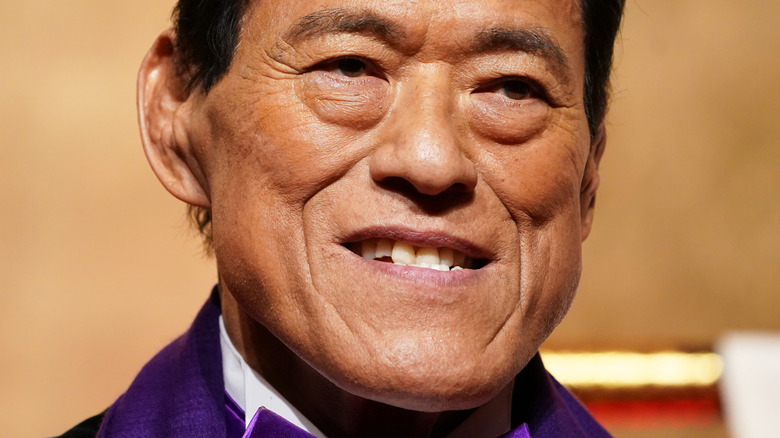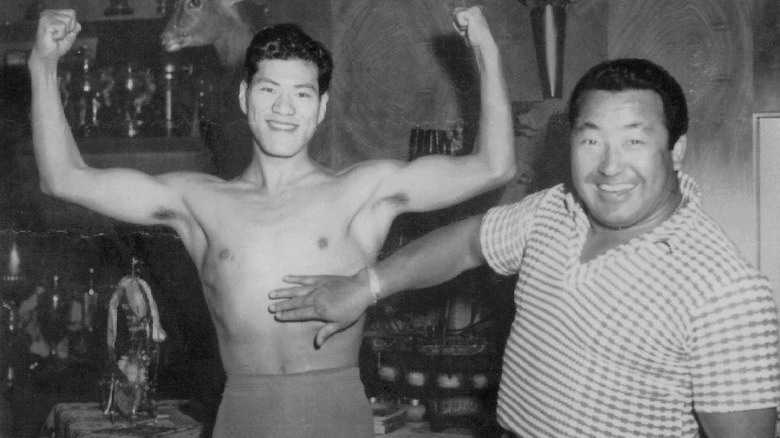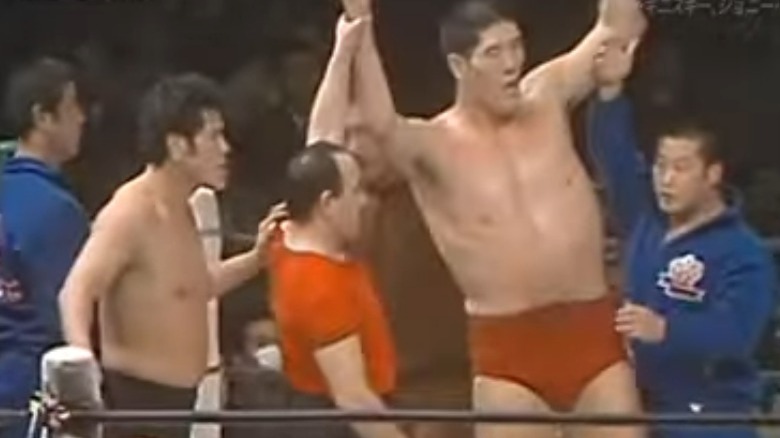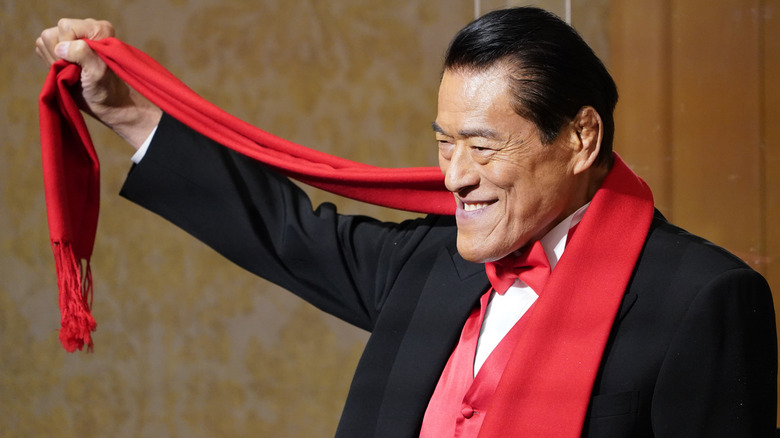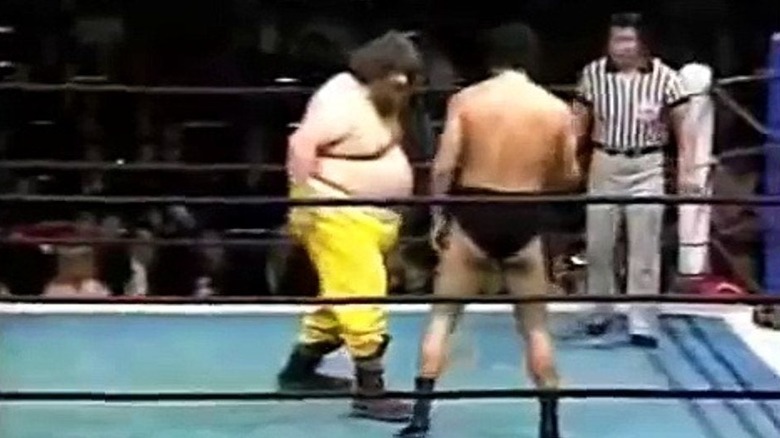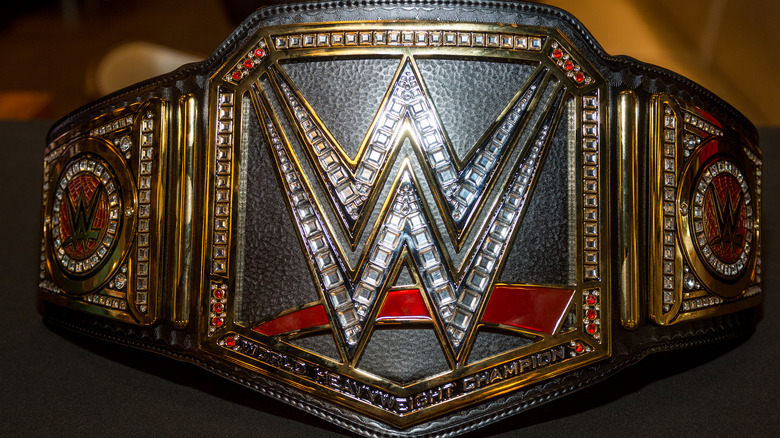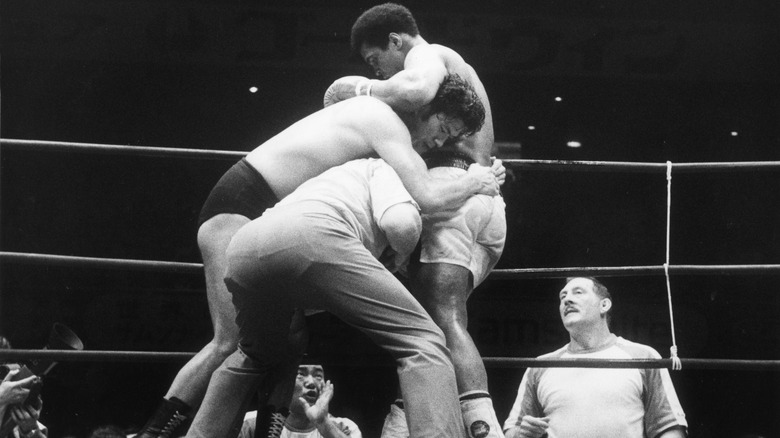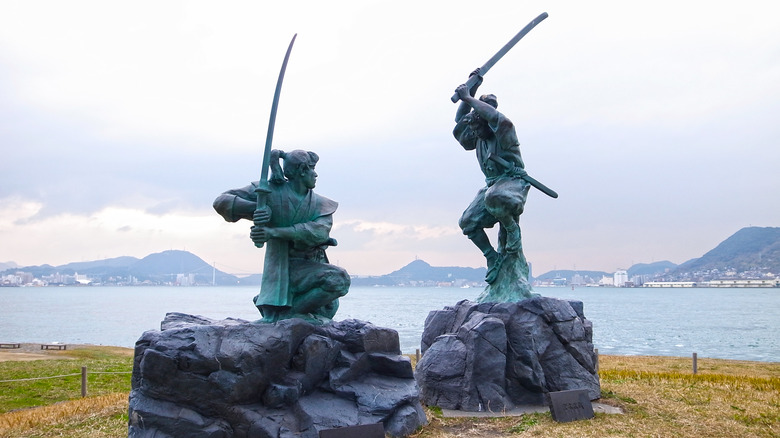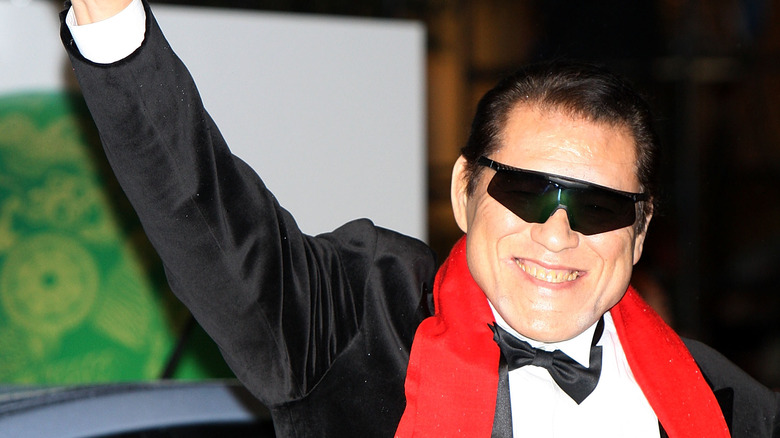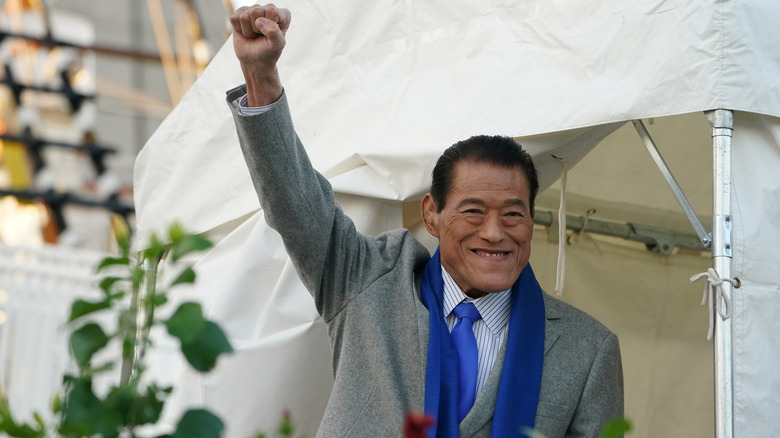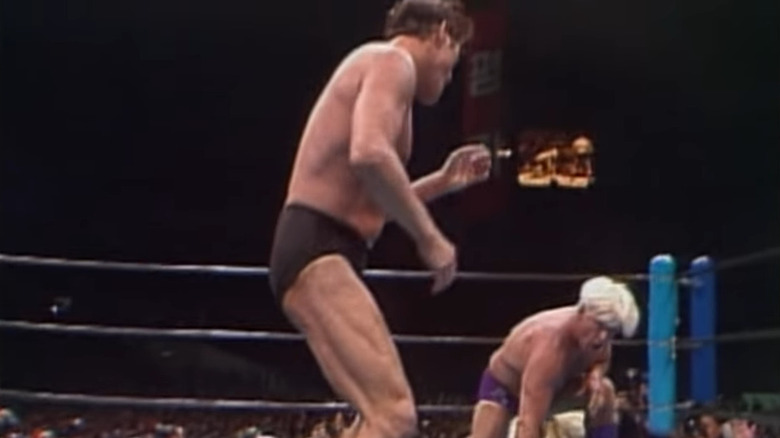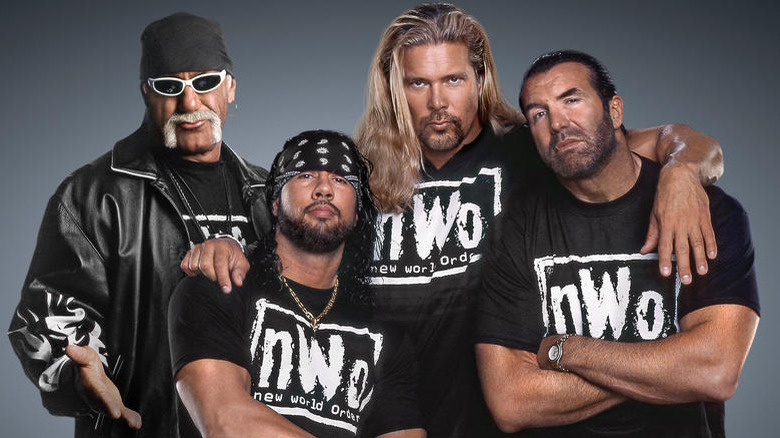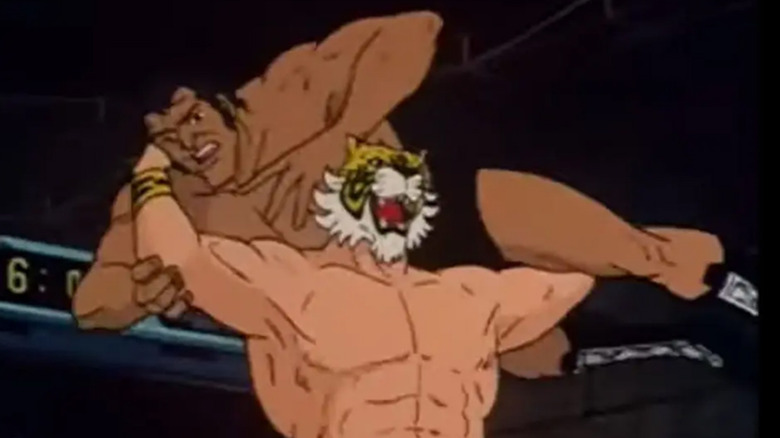Facts About Antonio Inoki Only Hardcore Wrestling Fans Know
Antonio Inoki, the legendary founder of New Japan Pro-Wrestling, passed away on October 1, 2022. To write a full biography of the man would take more than any one article could ever hope to do justice. With NJPW in the midst of its 50th Anniversary year, Inoki was just named Honorary Lifetime Chairman of the company that he sold in 2005, an honor that came posthumously, but was already in the works when Inoki passed.
Nevertheless, the man has a whole host of accomplishments to his name. Whether it be in the ring against such adversaries as Hulk Hogan, Andre the Giant, Tiger Jeet Singh, Masa Saito, Big Van Vader, or Umanosuke Ueda, or in the political arena, Inoki left a huge impact wherever he set his mind and body to. His boxing vs. wrestling match against Muhammad Ali set the blueprint for what would become a sport that would take over the world. And it was considered a great honor in Japan to be slapped by Inoki, in order to gain some of his famous fighting spirit. With this in mind, here are 12 things you may not have known about this one-of-a-kind wrestler and promoter.
Antonio Inoki Went By Three Different Names In His Life
Inoki went by several monikers throughout his life (if not his wrestling career). Born Kanji Inoki on February 20, 1943, in Yokohama, to a large and affluent family (he was the sixth of seven sons, with four sisters as well), he and the rest of his family emigrated to Brazil in 1957, when Inoki was 14 years old. It was in Brazil that Inoki caught the attention of Rikidozan, the father of Japanese pro wrestling. Returning to Japan to train under Rikidozan as his disciple, he debuted for his trainer's Japan Pro Wrestling Alliance (JWA) on September 30, 1960, in Tokyo, losing to Kintaro Oki. In 1962, Inoki took on the ring name of Antonio Inoki, named after wrestler Antonio Rocca, the name he is most famously known by.
However, in 2014, Inoki revealed in an interview that he had converted to Shia Islam during a sojourn to Iraq in 1990 taken in his capacity as a politician. Since that time, his legal name was Muhammad Hussain Inoki, although he continued to go by Antonio Inoki in his public life.
Inoki Was Partnered With Giant Baba Before Becoming His Rival
Inoki was one of the most famous acolytes of Rikidozan, but in his early days, he was considered second fiddle to another star of the JWA: former Yomiuri Giants pitcher, Shohei "Giant" Baba. As it happens, both Inoki and Baba debuted on the same day, with Baba winning his match. Inoki typically worked under Baba on the card in those JWA days, leading up to Rikidozan's death stemming from a street fight with yakuza gangsters on December 15, 1963. Afterwards, Inoki would go on a long excursion to the USA, working various territories, sometimes as Antonio Inoki, sometimes under names like Tokyo Tom, Kinji Onoki or Kazimoto. Returning to the JWA in 1967, Inoki and Baba were put together as a team, known as B-I Cannon. Baba was still considered the uppermost member of the team. Nonetheless, the tandem won the NWA International Tag Team titles four times between October 31, 1967, and their final loss of the titles to Dory Funk Jr. & Terry Funk on December 7, 1971.
Even so, the JWA saw fit to push Baba moreso than Inoki. To wit, in the post-Rikidozan era, Baba would win the World League tournament (the precursor to the likes G1 Climax and Champion Carnival) six times between 1966 through 1972; the only interruption was Inoki's sole win of the tournament in 1969.
Naturally, Inoki and Baba became rivals outside of the JWA as well, when both men would form New Japan Pro-Wrestling and All Japan Pro Wrestling, respectively.
Inoki Tried Other Companies Before Forming NJPW
When Inoki returned to Japan from his extended trip to the USA, he did not immediately return to the JWA. During Inoki's absence, the former sumo rikishi turned pro wrestler Toyonobori had resigned as president of the JWA in 1966, and would form his own company, Tokyo Pro Wrestling, along with Katsuhisa Shibata (the father of future NJPW star Katsuyori Shibata) and Masao "Rusher" Kimura. Inoki was promised to be the top man in the company, something that could not happen in JWA while Giant Baba was still there. Inoki had a hot feud with Johnny Valentine as one of the hallmarks of the company, but it was not enough. Toyonobori had frequent issues with his backers, and in 1967 ended the promotion.
Inoki returned to JWA in 1967, where he teamed with Baba, and continued there until Inoki was kicked out of JWA after trying to engineer a takeover of the company from its then owners. After that ignominious ending to his career at the promotion that brought him into wrestling, Inoki would form New Japan Pro-Wrestling, which held its first card on March 6, 1972, in Tokyo Ota Ward Gymnasium. And the rest, as they say, is history.
Inoki Got Into Several Shoots Over The Years
From time to time, in the midst of a match, wrestlers will find themselves in the midst of a "shoot," which is when a match goes off the script and becomes a real fight. Inoki was certainly no exception to this. Any early, notorious incidence of this came in Osaka, when Inoki and then-WWF champion Bruno Sammartino were engaged in a tag match. The legend goes that Inoki tried to show Sammartino who was boss in the ring, with a few unscripted holds. Sammartino didn't take kindly to that, getting Inoki into a particularly punishing front facelock, hitting away on Inoki before tossing him out of the ring. After that, Inoki and Bruno didn't have any ring interaction in that match, and indeed, Sammartino would never work for NJPW, choosing instead to work for Baba and AJPW when he went to Japan to wrestle.
Inoki would also get into a real scuffle during a match with the famed Akram Pahalwan in Pakistan. This fight saw Pahalwan bite Inoki on the arm, Inoki respond with an eye poke, and Inoki get the victory with a chickenwing arm lock that actually broke Pahalwan's arm after refusing to submit.
Possibly the most notorious shoot incident Inoki was a part of happened in the New Japan ring on December 8, 1977, at Tokyo Ryogoku Kokugikan. Inoki's opponent was famed Croatian-Canadian strongman The Great Antonio (Antonio Barichievich). Having built to this match with several handicap matches for the massive Great Antonio on that NJPW tour, Inoki's offense was completely no-sold by Antonio, and Antonio's offense was sloppy, to the point where instead of clubbing Inoki on the back, he hit Inoki's neck instead. At that point, Inoki took charge of the match, beating him to bloody unconsciousness, at which point the match had to be stopped.
Inoki Is An Unrecognized WWF Heavyweight Champion
The history of professional wrestling is littered with phantom and unofficial title reigns, for many and varied reasons. Unfortunately for Inoki, he was caught up in one of those historical instances.
On November 30, 1979, in Tokushima, Inoki wrestled WWF Heavyweight Champion Bob Backlund, defeating Backlund in a near 30-minute match, after interference from Tiger Jeet Singh allowed Inoki to pin Backlund. The very next week in Tokyo on December 6, 1979, the rematch took place, this time with the match being ruled a no-contest, also due to interference from Singh. Inoki then vacated the title, with Backlund wrestling Bobby Duncum at Madison Square Garden on December 17, 1979, to win the title back. However, for whatever reasons, WWE to this day does not recognize Inoki's brief reign as champion, and considers Backlund's tenure as the title holder to be one uninterrupted reign lasting nearly six years.
Inoki May Have Invented MMA
Inoki will forever be remembered as the founder of one of the biggest pro wrestling companies of all time in NJPW. It most assuredly will not be the only thing that will cement his legacy.
Inoki was known in NJPW to hold matches with fighters of different disciplines besides pro wrestling, such famed Pakistani wrestler Akram Pahalwan. He also fought several karateka and judoka, including the likes of Everett Eddy and Willie Williams.
The culmination of this idea was Inoki's match at Tokyo Nippon Budokan on June 26, 1976, against none other than "The Greatest," Muhammad Ali. The match saw boxing vs. pro wrestling on a scale never seen before. The fight itself is not well regarded, with Inoki spending much of the match on his back, hardly taking any punches from Ali. Ali's legs were injured for all the low kicks Inoki threw at him. It was a spectacle to be sure, one that ended in a draw after 15 rounds.
However, the idea of practitioners of different schools and styles fighting one another never fully went dormant, and Inoki continued his "different style fights" through the years, sometimes having other NJPW wrestlers take part in them as well. Come 1993, and two former students from the NJPW dojo, Masakatsu Funaki and Minoru Suzuki, formed Pancrase, arguably the very first Mixed Martial-Arts promotion, whilst in America, the Ultimate Fighting Championship held its first events as well.
Antonio Inoki may never get full credit for helping to spur this new combat sport along, but he certainly was one of the major groundbreakers of the sport.
Inoki Wrestled A Match On An Uninhabited Island
In 1987, Masa Saito went to NJPW, after having served two years in prison for assaulting a police officer in a notorious incident with fellow WWF wrestler Ken Patera. Inoki feuded with Saito through 1987, including the finals of that year's IWGP League, which crowned the first-ever IWGP Heavyweight Champion. Inoki won, naturally, but Saito wasn't done with Inoki yet. The blowoff to the feud was an "Island Deathmatch," held on October 4, 1987, on the uninhabited island of Ganryujima, near Shimonoseki Harbor in Japan.
The location of the match has an historical context. On April 13, 1611, the island was the site of a very famous duel in Japanese history, between the legendary swordsman Miyamoto Musashi, and his opponent, Sasaki Kojiro. Inoki, never one to shy away from invoking a famous battle, chose this as the venue, despite the fact there would be no crowd, and therefore no ticket sales for this match. A ring was set up on the island, but it was hardly used, as the wrestlers went against one another all over the island. The match itself went for over two hours, half of which under the cover of darkness as the sun had set during the bout. Inoki won by TKO, as Saito was unable to continue the match.
Inoki Starred In The Movie Acacia
As is often the case with sports celebrities, Inoki sometimes found himself on the silver screen. In 1978, Inoki made appearances in "The Bad News Bears Go To Japan," a family sports comedy that saw Inoki try to get a rematch with Muhammad Ali, but end up in the ring with the main character of the movie Marvin Lazar, played by Tony Curtis.
However, Inoki had a more dramatic turn in the 2008 movie "Acacia," written and directed by award-winning Japanese novelist & filmmaker Jinsei (Hitonari) Tsuji. The film sees Inoki star as a lonely, retired wrestler who ends up befriending a young child who is lonely in his own way, played by Ryoga Hayashi. Inoki probably did not have to do much research to ready himself to play a former pro wrestler. The film was presented for Competition at the 22nd Tokyo International Film Festival, held in 2009.
Inoki Had Two Stints As Member Of The Japanese House Of Councillors
Taking inspiration from both his father, who had been a politician, and Muhammad Ali to use sports as a way of promoting peace and unity, Antonio Inoki entered politics in 1989, getting elected to the House of Councillors, the upper house of the Japanese Diet, under his own Sports & Peace Party. Putting his ideals into action, Inoki travelled on an unofficial diplomatic mission to Iraq to negotiate the release of 41 Japanese persons being held in Baghdad after the invasion of Kuwait in 1990. This culminated in a two-day New Japan Pro-Wrestling event in Baghdad, the Sports & Peace Festival, held on December 2 & 3, 1990, which also featured a music concert and a soccer match. Ultimately, 36 of the hostages were released through Inoki's efforts, which helped Inoki get re-elected in 1992. However, he was unsuccessful in retaining his seat in the 1995 elections, and left politics.
Decades later, Inoki declared his return to politics on June 5, 2013, running for a seat in the House once more, this time under the Restoration Party banner, which he did win. After considering a run as a candidate for governor of Tokyo in 2014, Inoki changed parties several times through his second tenure in the Diet, before retiring from the political arena for good in 2019.
Inoki Hosted A NJPW Event In North Korea
Fueled by confidence in his abilities to negotiate peaceful solutions with rival nations, Inoki spent quite a lot of time in his political career trying to mend relations between Japan and North Korea. This was at least partially inspired by Inoki's old teacher, Rikidozan, who was a North Korean immigrant to Japan. The biggest showing of Inoki's dedication to his efforts was (you guessed it) a New Japan event, the Pyongyang International Sports and Cultural Festival for Peace, held on April 28 & 29, 1995, in Pyongyang, North Korea. There, the highest ever reported attendances for pro wrestling were recorded, with numbers between 165,000 and 190,000 reported for both shows. The event was also capped off by the one and only meeting in the ring between Inoki against Ric Flair, with Inoki beating the Nature Boy.
The event itself drew international attention, and would later be shown on tape delay as a WCW pay-per-view event called Collision in Korea. Only eight matches from the two days would be shown on the broadcast, including Inoki vs. Flair. It remains one of the few WCW events to not be posted to WWE Network. In 2021, VICE TV made the event the subject of an episode of "Dark Side Of The Ring," with Inoki himself one of the few Japanese persons interviewed about the Festival.
Inoki's mission was heartfelt, but got him into trouble more than once with the Diet. Indeed, during his second political tenure, Inoki was censured and suspended for 30 days by the legislature for another trip to North Korea in November 2013. Relations with his fellow legislators in the House of Councillors were rocky due to his trips to North Korea, none of which were official or authorized. It remains to be seen whether Inoki's efforts will have any positive effect in the long term.
An Inoki Angle In NJPW Inspired The NWO
New Japan has worked with many promotions, both in Japan and around the world, throughout its 50 year existence. One particular co-promotion angle may have inspired the storyline that catapulted pro wrestling into the mainstream spotlight in the late 1990s.
In the mid-1980s, a new company comprised of breakaway talents from NJPW called the UWF (Universal Wrestling Federation) was formed, promising a more realistic pro wrestling product based in catch and shoot wrestling. New Japan feuded with the UWF over several events. Cut to the mid-1990s, and the successor to UWF, now called UWFi (Union of Professional Wrestling Force International), were also in an "invasion" angle with New Japan that sold out several dates at the famed Tokyo Dome, and other venues as well. A major twist in the UWFi Invasion was the UWFi's top star, Nobuhiko Takada, submitting Keiji Muto to win the IWGP Heavyweight title. This set up the main event for Battle Formation in Tokyo Dome on April 29, 1996, where Shinya Hashimoto defeated Takada and reclaim the title for New Japan, ending the UWFi Invasion.
Inoki and then-booker Riki Choshu were behind this angle as a way to drum up business, and it worked. However, also in the crowd for Battle Formation was then-WCW president Eric Bischoff. He saw the way the angle of one company invading a much bigger one went over in Japan, and thought he could bring it back to America. Having WWF wrestlers Scott Hall and Kevin Nash become available fell in his lap, and once Hulk Hogan got involved, the new World order angle took wrestling by storm and changed the business forever. But it wouldn't have, without a little inspiration from Inoki and New Japan.
Inoki Has Appeared In Many Japanese Manga & Anime
Being referenced in a manga or anime is a sure sign you've made it as a pop culture figure in Japan. Antonio Inoki first appeared in a manga in the original "Tiger Mask" strip, which ran from 1968 through 1971 in several magazines. Inoki was the only wrestler shown to beat the titular character in the ring during the series. Of course, since that time, several wrestlers through the years have donned a Tiger Mask outfit and gimmick across several different promotions, including Satoru Sayama, Mitsuharu Misawa, Koji Kamemoto, and Kota Ibushi.
Through the years, Inoki has been referred to, or guest starred, in numerous manga and anime, as diverse as children's classic "Doraemon," to the violent "Baki The Grappler." More recently, a character very much based on Inoki appeared as a main character in "Golosseum" by Yasushi Baba, a series where a lot of characters who bear more than a slight resemblance to famous wrestlers team up with Rasputin The Mad Monk to take down a fictitious Vladmir Putin analogue using alien weaponry.
If that wasn't enough, Inoki's image and signature enzuigiri kick were the basis of the Fighter Hayabusa character in Nintendo's "Pro Wrestling" game for the NES, one of the earliest pro wrestling video games. A winner is Inoki!
